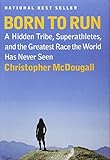Edit: Maybe this? https://www.amazon.com/Born-Run-Hidden-Superathletes-Greates...
>this kind of collision leads to a rapid, high impact transient about 1.5 to as much as 3 times your body weight (depending on your speed) within 50 milliseconds of striking the ground (see graph a below).
>This is equivalent to someone hitting you on the heel with a hammer using 1.5 to as much as 3 times your body weight. These impacts add up, since you strike the ground almost 1000 times per mile!
taken from:
http://barefootrunning.fas.harvard.edu/4BiomechanicsofFootSt...
It is impossible to run this way with undamped shoes or barefoot.
I recommend this book (not affiliated):
https://www.amazon.com/Born-Run-Hidden-Superathletes-Greates...
is really fun to read, it is about a indigenous tribe in mexico which run in sandals cut from old tires, for 24 or 48 hours straight. In there is a reference to another study where they found a correlation between cost of the shoe and the rate of injuries: more expensive shoes with better damping had higher rates of injuries, they weren't expecting this.
Our legs evolved to store the energy in our tendons and release it to propel us forward. A QUARTER of the bones in our body is in our feet! Humans evolved to be the best endurance runners on the planet, being "naked" (without fur) is actually an advantage for running, enabling us to cool down our bodies by sweating. There are still tribes hunting their prey by running after it for prolonged periods till it collapses from overheating. There are races for horses, humans started to compete in. Initially the runners where ridiculed but someday a human won the race.
https://www.amazon.com/Born-Run-Hidden-Superathletes-Greates...
It's a fun story too. I don't know if we're actually born to run or not, but it's inspiring either way.
We do?
The larger point being made that we are "born to run" is a more interesting one, though not at all new. If you haven't read it, you should check out the book of the same name, which argues the same position (besides having an excellent story): http://www.amazon.com/Born-Run-Hidden-Superathletes-Greatest...
There is a whole book written about this. There are several conversations in the book with this same professor. I would definitely say this book has changed my life.
In more than a few places, I was pretty sure that book was written specifically for me. My dad was in the process of getting knee surgery right when I picked it up. There was a section that detailed a doctor visit the author had, where the doctor told him his only recourse was to have the same surgery my dad was having. Two years later, the author (who didn't have the surgery) is still running barefoot around central park, yes on asphalt and concrete and any other substrate you can imagine. My dad is not. My dad used to come home and run for hours every day after work. Now he doesn't run at all.
Just thought I'd share some points in the book that I love and find relevant to this discussion so far...
Not mentioned in the article but Lieberman talks about it in the book, is the fact that all four-legged animals can only breath one time per stride. A running cheetah operates like a large bellows. When he extends, his diaphragm (which is attached to the pelvis) pulls back and forces the lungs open, forced inhale. When they stride, all their organs literally slosh forward in their horizontal bodies, compressing the diaphragm, forcing an exhale. Humans standing upright allows us to breath whenever we feel like it while running. No other animal can do that.
Also about the Man vs Horse race. Unless the dude sitting on the horses back is a sumo wrestler, it probably doesn't count for much. A horse that is 1200lbs of muscle has a 150lb man sitting on his back. That's equivalent to wearing a 10lb backpack. I'm not saying you wouldn't notice it, but you can't blame the backpack for losing the race. The real reason is that a horse can only outrun a human for 10-15 miles, at which point the horse has to slow down to a maintainable pace, or die. Humans have no such restriction.
And as for running on asphalt - we have the best shock absorbers science has ever seen...they're called knees. Air cushioned soles and arch support, pronation and supination control, torsion bars, built in computer chips to monitor your (incorrect) foot strike and adjust the shoe on the fly are all awesome - if you won't be needing your feet ankles and knees in old age.
I don't recommend many books, but read this one. Even if you don't run, hate running, have never run in your life. You will love your feet when you're done.
The best book of 2010 for me "Born to Run: A Hidden Tribe, Superathletes, and the Greatest Race the World Has Never Seen" by Christopher McDougall: http://www.amazon.ca/Born-Run-Hidden-Superathletes-Greatest/...
There are so many great things about this book. It has an amazing story and also delivers a message why humans were born to run.
http://www.amazon.com/Born-Run-Hidden-Superathletes-Greatest...
http://www.amazon.com/Born-Run-Hidden-Superathletes-Greatest...
1. http://www.amazon.com/Born-Run-Hidden-Superathletes-Greatest...
The Tarahumara people have been known in the elite runner/super athlete circles for a few decades yet but it seems that since the book came out everyone has been searching for their own experience with them. They are also somewhat responsible for the recent barefoot running phenomenon.
Born to Run: A Hidden Tribe, Superathletes, and the Greatest Race the World Has Never Seen
http://www.amazon.com/Born-Run-Hidden-Superathletes-Greatest...
(if you are not interested, I wager after starting the book you will be :-))


Looks like this[1] post goes into the debate, as framed by the book, but I'm on mobile and haven't read through it so YMMV.
[0] https://www.amazon.com/Born-Run-Hidden-Superathletes-Greates...
[1] https://www.chrismcdougall.com/born-to-run/the-barefoot-runn...